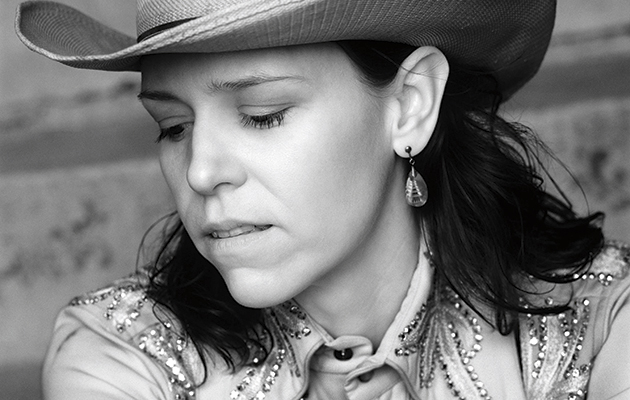Welch remains a pleasingly human bundle of contradictions: a cowboy boot-wearing romantic who venerates old Nashville – “I arrived 34 years too late,” she says – while drinking organic raw Kombucha (a wholefood store speciality of fermented and chilled green tea) and filming Dixie on her iPhone.
“I’m sorry that I confuse people, simply by being what I am,” she says, not altogether penitently. “But I’ve constantly marched towards where I am today. In urban environments, I continuously found the sounds that I liked, and they were often quite hard to find. The main thing is, Dave and I just think about music. All the time. That’s all we do. And I kinda feel like all decisions are musical. We’re not even thinking about how it looks to people. I can barely, barely, do this. Barely. I can barely satisfy myself. There’s not a chance in hell I could do stuff to satisfy other people.”
“Gill and Dave clearly work in a completely different way to many people I know,” says Colin Meloy. “I get the feeling, for all their love of simplicity and clarity, that they come from a kind of insanely finicky place. So many of her songs feel so off-the-cuff, so underthought, but there’s a lot of thinking that goes on, I think, to get to that place.”
At the end of June, Gillian Welch released her fifth album, The Harrow And The Harvest, a collection with a creation myth that bears out Meloy’s suspicions. Unlike Soul Journey, which was fleshed out with a full band, The Harrow And The Harvest features just Welch and Rawlings in their studio, playing ten new folk songs that sound like they have been fastidiously whittled down to their essences. This process seems to have taken eight years. Hence the agrarian metaphor of The Harrow And The Harvest: before you reap any rewards, an awful lot of hard work has to be done preparing the land.
Friday May 13. Gillian Welch, 43, and David Rawlings, 42, are conducting a guided tour of Woodland Studios, Nashville. Built in the 1920s as a cinema, Woodland was converted into a studio by Glenn Snoddy, the engineer who cut “Your Cheatin’ Heart” and “Ring Of Fire” straight to acetate, and who purportedly invented fuzztone. By the 1970s, Woodland’s two studios were producing country hits around the clock, while also opening their doors to rock musicians; Neil Young recorded Comes A Time there.
When Welch and Rawlings bought it a decade ago, however, Woodland was a run-down digital establishment, in an unfashionable neighbourhood, that had been on the market for a year. “People were looking to tear it down,” says Welch.
Nowadays, this stretch of East Nashville is home to the city’s more bohemian residents. There is a yoga studio nearby, and a restaurant that sells quinoa salad rather than barbecue. At one end of Woodland, the offices of Welch and Rawlings’ label, Acony, reflect the local ambience: quietly modern, impeccably organised, busy this afternoon trying to put an end to internet rumours that The Harrow And The Harvest even exists.
At the other end, though, the pair have built a temple to analogue recording, a meticulous homage to old Nashville that has been tailored entirely to their own ends. In the ten years they have occupied this sizeable building, only their own projects – and a couple more on their Acony label – have been recorded here, with just one significant visitor from the outside world: Robert Plant, who made Band Of Joy in the cavernous Studio A.
As Welch and Rawlings stand in the control room, proudly discussing their antique kit (the mixing desk, it transpires, comes from Boston and was used to record Sesame Street tunes), it becomes apparent that, even by the standards of most musicians, they are peculiarly obsessive about sound. Rawlings, in particular, has extraordinary ears: at a radio studio later in the afternoon, he will be distracted during a live session by a clock whose ticking only he can hear. “He’s like a bloodhound,” says Welch. “He won’t stop working.”
The extent of Welch and Rawlings’ mania becomes apparent when they open up Woodland Studio B, where The Harrow And The Harvest was recorded. 2001’s outstanding Time (The Revelator) was recorded on the other side of Nashville at RCA Studio B, a cramped facility where artists jostle for space with tourists admiring the old haunt of Elvis Presley and Roy Orbison.
“We’re very private people,” says Welch, and it seems odd that they could ever have worked in such a public environment. But given how much they liked RCA Studio B’s vintage, unsullied sound, they took what, to them at least, seemed the only logical course of action. They built an exact recreation of RCA Studio B in a room which Rawlings had previously used to practice his golf swing.
The photographs on the inside sleeve of Time (The Revelator) attest to the success of the reconstruction. The chequerboard linoleum is the same, as is the cypress wood skirting, and many of the instruments – a Hammond B3, a xylophone – lined up along the walls. There is, shockingly, a slight disparity in the size of the wall tiles. In the middle, there are two old wooden chairs and a small table, sat on a rug and surrounded by microphones. The microphones are covered with small plastic bags, and have not been moved since The Harrow And The Harvest was completed in early March. This is how plenty of the last eight years was passed – designing the perfect, historically redolent, recording environment. “We got to a place,” says Welch, “where we had such confidence in our set-up that if we didn’t get something right, we didn’t question the sound, we questioned what we were doing.”
And that, perhaps, was where the trouble really started.



